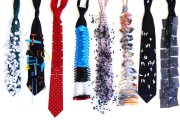Karol Pichler entered the art scene in the mid 1980s. Despite studying applied arts, he has presented his work at most of the important curated exhibitions of contemporary Slovak visual art...
Inventory No.: F-138/1 — 12
Artist: Karol Pichler
Title: from the Ties series
Year: 2002 — 2012
Technique: combined
Material: combined
Dimensions: variable
Signature: none
Karol Pichler entered the art scene in the mid 1980s. Despite studying applied arts, he has presented his work at most of the important curated exhibitions of contemporary Slovak visual art: Objects & Installations, 1992; Labyrinths, 1993; Physical-Mental, 1995; Between a Man and a Woman, 1997; Lost Paradise / Baroque Today, 1998; 20th Century Art, 2000; Autopoesis, 2006; Postmodernism in Slovak Fine Art 1985-1992, 2009. When he taught at the Secondary School of Applied Arts in Bratislava he influenced a lot of students and future artists (Denisa Lehocká, Boris Ondreička, Dorota Sadovská, Anabela Žigová). The work of Karol Pichler is characteristic with neo-conceptual tendencies (ready-made, texts, signs, and symbols). He overlaps applied art with fine art and moves between different media (objects, installations, videos). Many of his works are based on interaction requiring the recipient’s intensive mental and physical cooperation which is similar to an experience of playing a game. Karol Pichler uses ephemeral materials like paper and textile and in his installations he puts ready-made objects of various kinds and origins into a broader perspective. He also uses pictograms and other information and communication schemes. The artist can be very scrupulous about the design of his works, but also about their multi-level content. Pichler finds his inspiration in the hermetic “secret” traditions of the West (Neo-Platonism, Kabbalah, Rosicrucianism, the magic and mysticism of geometrical shapes, colours and numbers), he often uses numerical codes and elementary symbolism (the motives of a circle, cross, labyrinth, swastika…). He gives his works strictly Latin titles. Besides fine art, Pichler also pursues scenic design (among others, he created the set for a large Yves Saint Laurent show in Rio de Janeiro) and fashion design. He has a passion for suits and collects ties.
Nitra Gallery has a collection of twelve ties from the Ties series created since the late 1980s. They are a true representation of Pichler’s sense for combining the applied and fine arts, the functional (in this case, wearable) and visually attractive. The artist makes the ties himself and actually wears them, but when they are on display as a part of an exhibition, we can perceive them as pieces of art. He takes a very creative and playful approach to creating them. Pichler uses unconventional materials such as leather or neoprene. Other ones are made of bags of ink, old pictures sawed into plastics or with small plastic figures, objects or toys attached to them. The artist’s signature feature is tagging fasteners, the small plastic threads that are used to attach brand tags on clothing items. They create visually interesting, “bushy” ties that are peculiar to touch. Pichler either lets the fasteners take over the whole tie or uses them to attach objects like letters or pictures.
The ties are not supposed to be just artistic fashion items. Pichler also uses them as props to express the current state of (his own) mind, moods, attitudes, stories or creative thinking; either by wearing them “live” or by posing for photographic portraits.
The art critic Petra Hanáková expresses her position on Pichler’s eye-catching fashion style: “His interest in extraordinary ties or other fashion accessories he makes himself have always made his presence (not just at exhibition openings) a sort of an event or an ad-hoc self-performance. Even in his professional career, Pichler has always been interested in the performance, action and variable possibilities of textile.” [1]
The philosopher and aesthetician Peter Michalovič describes the new meanings of the Ties and the way they might talk to the audience (even through photography): “At the beginning, there were ordinary ties. For instance, a tie with painted bubbles. However, the moment the artist tied the tie around his neck and blew into a bubble blower, the tie stopped being a part of the outfit and became a part of the performance. What was painted on the tie suddenly extended itself into space. Or a tie sprinkled with letters started to talk to the writings on the artist’s fingers. Lastly, a tie can represent a modest canvas with painted figures of people that serves as a basis for a small narrative. It has been said that an artist can be both a creator and a recipient. Pichler often wants the viewer not to be just a passive recipient, but a co-creator.” [2]
Karol Pichler was born December 22nd, 1957 in Bratislava. Between 1973 and 1977 he studied textile design at the Secondary School of Applied Arts in Bratislava. Between 1980 and 1985 he studied painting and tapestry and the University of Applied Arts in Budapest. He has exhibited at many solo and group exhibitions in Slovakia and abroad. In 2009 he became a laureate of the designer competition prize “22° Premio Design” in Museo da Casa Brasileira in Sao Paulo, Brazil. Since 1997 he has lived and worked alternately abroad (Paris, Rio de Janeiro).
Omar Mirza
December 2016
Notes:
[1] Hanáková Petra: Karol Pichler, in: http://www.arslexicon.sk/?registre&objekt=pichler-karol (search results from 29 December 2016).
[2] Michalovič Peter: Karol Pichler. A tie is (and is not) a tie, Flash Art Czech & Slovak Edition, No. 25 (September–December 2012), Vol. VI, ISSN: 1336-9644, p. 45.

This acquisition has been supported using public funds provided by the Ministry of Culture of the Slovak Republic.













